Expert Foot & Ankle Treatment from Michigan’s #1 Podiatrist - Balance Foot & Ankle Specialist
Dorsal Compression Syndrome
Causes, Symptoms & Best Treatment
Dorsal Compression Syndrome is a painful condition most often caused by the gradual flattening of your foot, which leads to excessive pressure on the top portion of the midfoot. This biomechanical issue can result in the formation of bone spurs, compression of nerves, joint inflammation, and eventually arthritis if left untreated. The pain typically worsens with walking, running, or wearing tight shoes, and can severely limit your mobility. Early diagnosis and proper treatment are essential to prevent long-term damage and restore comfort. Don’t wait—fix it today with custom orthotics, expert evaluation, and proven therapies designed to relieve pressure and correct the underlying cause.
Top of the Foot Pain:
Dorsal Compression Syndrome Foot Treatment Video
Dorsal Compression Syndrome Foot Causes
Top of the Foot Pain Picture Gallery:
The most common causes of top of the foot pain:
- Top of the foot nerve compression.
- A swollen top of the foot can also occur due to stress across the top of the foot.
- Lisfranc fracture or sprain.
- Sprained top of the foot.
- Top of the foot bone spur.
- Hallux rigidus or dorsal 1st metatarsal joint spur.
- Dorsal foot compression syndrome.
- Flat foot compression leading to osteoarthritis.
Picture gallery of sharp pain on top of foot .
Dorsal compression syndrome overview:
- The dorsal foot is another way to say the top of the foot. Compression means that the bones on top are crushing under your body weight every time you take a step.
- This is like bending a piece of wood. It compresses on one side while it starts to stretch on the other side.
- This commonly occurs when people are not flexible enough in other parts of their hips, knees, hamstrings, calf muscles, or ankles. We usually see this as people get older or have suffered a prior injury, and they become less flexible and carry more weight.
- The key to preventing dorsal compression syndrome in the future is to wear great inserts, great shoes and gradually start to increase your flexibility while decreasing your weight. That is the magic formula!.
- Sometimes you can develop a bone spur on top of your foot, and bone spur surgery for the top of the foot may be advocated, but this is very unlikely for most people.
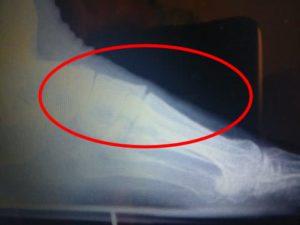
What Is Dorsal Compression Syndrome?
Dorsal compression syndrome occurs when there is excessive strain placed on the arch of the foot.
- The bottom of the arch becomes stretched.
- This is one of the most common causes of foot pain in the world.
- The top of the foot becomes compressed.
- The top of the foot can form arthritis.
- It can also be trapped nerves that cause numbness, burning, and tingling.
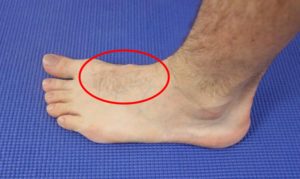
Why Top of Foot Pain?
- The top of the foot pain is usually due to nerve irritation.
- Nerve pain can be controlled very well at home.
- In 1-2 weeks, with this treatment guide, the nerve pain should disappear!
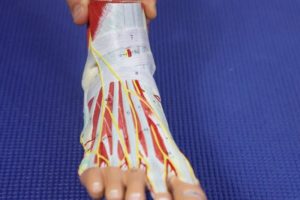
Symptoms:
- The stretching of the arch will cause plantar fasciitis.
- This results in heel and arch pain.
- This pain is the worst in the morning.
- Compression of the bones will cause soreness and bone pain over time.
- This can cause both nerve irritation and arthritis.
- Nerve irritation manifests as numbness, burning, and tingling.
- If you have a bony irritation and bump on the top of the foot, this is arthritis.
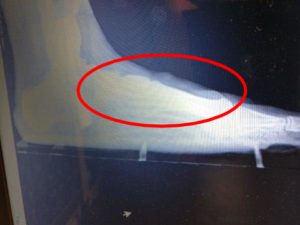
Related Causes:
1) Top Of Foot Numbness Or Tingling:
- The top of foot tingling associated with dorsal compression syndrome is usually due to nerve irritation.
- The medial dorsal cutaneous nerve is most frequently affected.
- This nerve covers the bump on top of your foot and runs along the top of your big toe.
- If a nerve is irritated and becomes numb, this is known as neuropraxia.
- Neuropraxia can take up to a month to get better, so treat it properly!
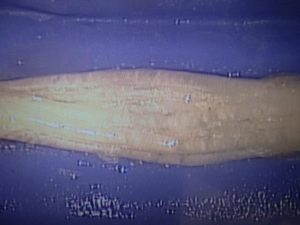
2) Top Of The Foot Bone Spur:
A bone spur on top of the foot forms due to abnormal friction and stress on the bone.
- As the bones of the mid-foot rub against each other, the bone re-enforces itself.
- This is similar to a callus forming in a high-pressure area.
- The same thing will happen to the bone on the top of your foot.
- A top of the foot bone spur is widespread.
- It can lead to the top of the foot numbness, burning, and tingling.
- This occurs due to nerve compression.

3) Metatarsal Stress Fracture:
- If you are a runner or started heavy walking.
- This does not happen instantly!
- It can take days or weeks to start hurting and causing pain gradually.
- Eventually, this will get too excruciating to continue walking or running.
- This can take 10-21 days to show up on X-ray.
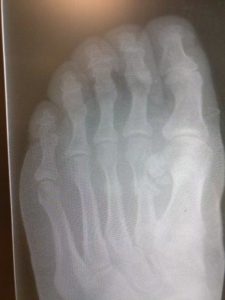
This is a fracture of the 2nd metatarsal after bone callus has formed. This is over 3 weeks after the original fracture site.
4) Sprained Top Of The Foot:
- A sprain in the top of the foot or the arch is called a Lisfranc sprain.
- In most cases, it is usually only a sprain that lasts a couple of days to a couple of weeks.
- But in some cases, it may be essential to seek imaging & further treatment.
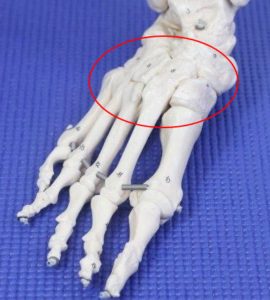
5) Fluid Cyst:
- Ganglionic cysts are soft masses across the top of the foot which are not immediately dangerous!
- These are simply pockets of fluid that pouch out from the joints of your foot bones like a balloon.
- Treatment consists of draining and removing the pocket of fluid.
- But they should still check out by a podiatrist because there is a chance that they may be something a little more dangerous.
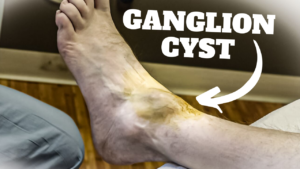
6) Plantar Fasciitis – Entire Arch Pain.
- This is by far the most common pain in the arch of your foot.
- 15% of all people around the world have it.
- If it feels painful in the morning & painful after walks, this is the first thing you should consider.
- Plantar fasciitis is usually related to flat foot & is due to the stretching of the tissues in the middle of your foot!
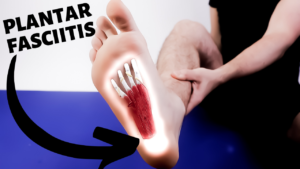
Surgery for dorsal compression syndrome:
Sometimes a bone spur does develop on top of the foot. Your podiatrist can work with you to work that up through x-ray imaging and or MRI.
- If it is determined that your bone spur is responsible for the pain and conservative nonsurgical therapy was not effective, it might mean that surgery is an option.
- The goal of surgery is to clean out the Spurs developing around the joint. This is a fairly straightforward and effective surgery.
- The good news is while the recovery is reasonably quick and effective: the key is to permit a new spur from developing.
- This means that you still need to increase your flexibility, get good orthotics, get good shoes and get better overall shape.
- You can’t just go back to barefoot walking and expect to be pain-free for the rest of your life!
- For this reason, we strongly recommend nonsurgical therapy to start with.
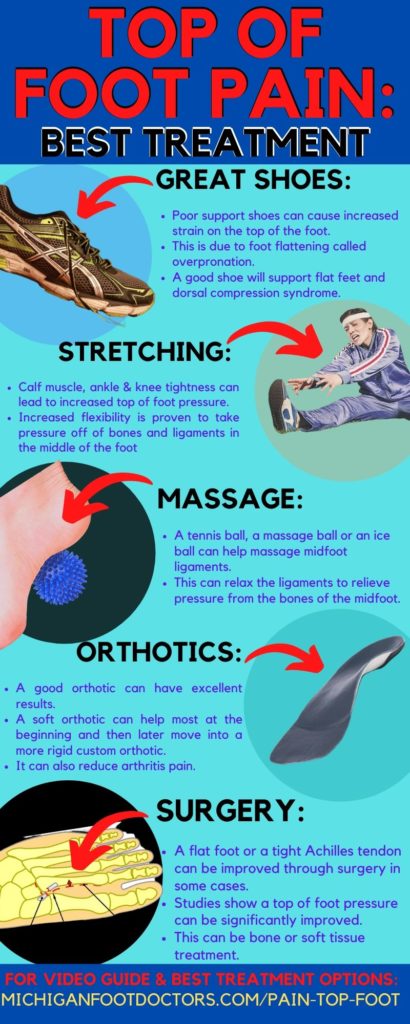
Top of the Foot Home Treatment:
- There are usually two phases to treating the gout on top of the foot pain treatment.
- This doesn’t matter whether it’s an intermittent sharp pain on top of the foot, pain on top of the foot near toes, tendonitis on top of the foot, or a top of the foot bone spur. Treatment is all roughly very similar.
- The two phases of treatment include controlling the acute inflammation and correcting the biomechanics, which led to the problem in the first place.
- Great top-of-the-foot shoes and great orthotics lead to the prevention of dorsal compression syndrome. This prevents compression on top of the foot. It prevents the stretching on the bottom of the foot.
- This will also reduce your numbness, burning, and tingling pain.
Control Inflammation:
Massage & Ice Products:
- The metal ball is one of my personal favorites.
- This can work well for a bruised top of the foot.
- This is not a permanent solution. You still need to remove the stress off of the top of the foot.
Best Foot & Ankle Manual Massage Devices:
Best Premium Massage Roller
Most Cost Effective Massage Roller.
Cost Effective Freezable Massage Roller.



Price:
Price not available
$7.99
$11.99
Overview:
Premium freezable metal ball that stays cold for up to 6 hours. Great for plantar fascia, neck, shoulders and calf muscles.
Amazing Price, Great Reviews – Non-Freezable Massage Rolling Stick
Great price and it is freezable. Budget friendly freezable massage roller.
Pros:
Great reviews – near 5 star. Stays cold for a long time with deep penetrating plantar fascia massage. Used by professional athletes. Stays cold for HOURS!
Great for what it does. You roll it back and forth along your plantar fascia massaging the swelling and irritation out. Decreases pain. Thousands of 5 star reviews on Amazon.
Excellent reviews. It massages and ices, so it is a step up over the massage rollers. Near 5 star reviews with >500 reviews.
Cons:
More expensive than some of the other options, but near perfect reviews.
Is not freezable like the other two options. Massaging a sore muscle without the cold sensation can be very painful and render it useless to you if really sore.
It does a great job doing what it is supposed to do. Main downside is that it does not stay cold as long as the premium metal ball.
Important Tips:
Use it with a sock to start (could be too cold). Massaging and icing definitely loosens you up and makes you feel better, but you still have to prevent the pain in the first place. You still need stretching, orthotics and good shoes to prevent the initial damage.
Two things: Without the freezing component, it may be really painful for a very sore arch (So make sure to use ICE also). Also this only reduces pain, it does not stop the cause! You still need good orthotics, shoes and stretching to stop the pain in the first place!
Start with socks at first, especially if you have peripheral neuropathy => don’t freeze your foot! Remember that you still need good orthotics, good shoes and inserts as well as temporary activity reduction.
Affiliate Link (Buying through these links will connect you to Amazon):
Best Foot & Ankle Manual Massage Devices:
Best Premium Massage Roller

Price:
Price not available
Overview:
Premium freezable metal ball that stays cold for up to 6 hours. Great for plantar fascia, neck, shoulders and calf muscles.
Pros:
Great reviews – near 5 star. Stays cold for a long time with deep penetrating plantar fascia massage. Used by professional athletes. Stays cold for HOURS!
Cons:
More expensive than some of the other options, but near perfect reviews.
Important Tips:
Use it with a sock to start (could be too cold). Massaging and icing definitely loosens you up and makes you feel better, but you still have to prevent the pain in the first place. You still need stretching, orthotics and good shoes to prevent the initial damage.
Affiliate Link (Buying through these links will connect you to Amazon):
Best Foot & Ankle Manual Massage Devices:
Most Cost Effective Massage Roller.

Price:
$7.99
Overview:
Amazing Price, Great Reviews – Non-Freezable Massage Rolling Stick
Pros:
Great for what it does. You roll it back and forth along your plantar fascia massaging the swelling and irritation out. Decreases pain. Thousands of 5 star reviews on Amazon.
Cons:
Is not freezable like the other two options. Massaging a sore muscle without the cold sensation can be very painful and render it useless to you if really sore.
Important Tips:
Two things: Without the freezing component, it may be really painful for a very sore arch (So make sure to use ICE also). Also this only reduces pain, it does not stop the cause! You still need good orthotics, shoes and stretching to stop the pain in the first place!
Affiliate Link (Buying through these links will connect you to Amazon):
Best Foot & Ankle Manual Massage Devices:
Cost Effective Freezable Massage Roller.

Price:
$11.99
Overview:
Great price and it is freezable. Budget friendly freezable massage roller.
Pros:
Excellent reviews. It massages and ices, so it is a step up over the massage rollers. Near 5 star reviews with >500 reviews.
Cons:
It does a great job doing what it is supposed to do. Main downside is that it does not stay cold as long as the premium metal ball.
Important Tips:
Start with socks at first, especially if you have peripheral neuropathy => don’t freeze your foot! Remember that you still need good orthotics, good shoes and inserts as well as temporary activity reduction.
Affiliate Link (Buying through these links will connect you to Amazon):
Menthol Based Gels:
- Biofreeze is one of our favorites.
- These gels have been studied to work 2x as long as ice.
- This can also work as a great option for a bruised top of the foot or top of the foot extensor tendonitis.
- This is not a permanent solution. You still need to remove the stress off of the top of the foot.
Best Foot & Ankle Muscle/Ligament Pain Relief Products
Best & Proven Pain Relieving Gel.
Roll On Version of Biofreeze Gel.
A giant container of value size biofreeze.
Menthol Based Ointment with Hemp Extract




Price:
Price not available
$35.15
Price not available
$19.99
Overview:
The Proven and Scientifically Published Menthol Based Gel
Same as biofreeze gel, but the roll-on is prefered by some people for their feet, less messy.
8.1 lbs(3.67 kg) of Value Sized Biofreeze!
This is an alternative cream: Basically Biofreeze + hemp extract.
Pros:
Scientifically proven to loosen up and relief pain up to 2x longer than Ice. Less effort than ice and great reviews. 900+ 5 star reviews on Amazon.
The roll-on application of this biofreeze can be easier to apply. Less overall mess.
If you know you already love it and trust the reviews. This is a great value that lasts a long time.
It has great reviews, loved by the all natural crowd. 100s of 5 star reviews with a near perfect rating.
Cons:
Don’t put this on open sores or mucous membranes, it will burn! It can run out quick and doesn’t prevent pain, just helps it.
Not as easy to spread in other areas, main difference is the roll on applicator, same solution.
A gigantic bottle that could fall over and injure you! Seriously this could be too big in some situations.
Basically looks like menthol(active Biofreeze ingredient), but with hemp extract SKYROCKETING the price.
Important Tips:
Menthol is the active ingredient in this and other hemp based creams. It works similar to ice, but once you apply it you can just move on rather than waiting 20 minutes. **Works great to get your through the night if you have pain sleeping**
Roll-on method is best for the bottom of the feet. No other real advantage. Most patients like it prior to bed for easy sleeping without foot pain.
If you know you love it, this stuff works all over the sore areas in your body not just your foot. I have had many people get me to order this for them in the past and LOVED IT!
The hemp extract is almost nothing and likely a marketing gimmick. It’s basically Biofreeze with some hemp extract raising the price.
Affiliate Link (Buying through these links will connect you to Amazon):
Best Foot & Ankle Muscle/Ligament Pain Relief Products
Best & Proven Pain Relieving Gel.

Price:
Price not available
Overview:
The Proven and Scientifically Published Menthol Based Gel
Pros:
Scientifically proven to loosen up and relief pain up to 2x longer than Ice. Less effort than ice and great reviews. 900+ 5 star reviews on Amazon.
Cons:
Don’t put this on open sores or mucous membranes, it will burn! It can run out quick and doesn’t prevent pain, just helps it.
Important Tips:
Menthol is the active ingredient in this and other hemp based creams. It works similar to ice, but once you apply it you can just move on rather than waiting 20 minutes. **Works great to get your through the night if you have pain sleeping**
Affiliate Link (Buying through these links will connect you to Amazon):
Best Foot & Ankle Muscle/Ligament Pain Relief Products
Roll On Version of Biofreeze Gel.

Price:
$35.15
Overview:
Same as biofreeze gel, but the roll-on is prefered by some people for their feet, less messy.
Pros:
The roll-on application of this biofreeze can be easier to apply. Less overall mess.
Cons:
Not as easy to spread in other areas, main difference is the roll on applicator, same solution.
Important Tips:
Roll-on method is best for the bottom of the feet. No other real advantage. Most patients like it prior to bed for easy sleeping without foot pain.
Affiliate Link (Buying through these links will connect you to Amazon):
Best Foot & Ankle Muscle/Ligament Pain Relief Products
A giant container of value size biofreeze.

Price:
Price not available
Overview:
8.1 lbs(3.67 kg) of Value Sized Biofreeze!
Pros:
If you know you already love it and trust the reviews. This is a great value that lasts a long time.
Cons:
A gigantic bottle that could fall over and injure you! Seriously this could be too big in some situations.
Important Tips:
If you know you love it, this stuff works all over the sore areas in your body not just your foot. I have had many people get me to order this for them in the past and LOVED IT!
Affiliate Link (Buying through these links will connect you to Amazon):
Best Foot & Ankle Muscle/Ligament Pain Relief Products
Menthol Based Ointment with Hemp Extract

Price:
$19.99
Overview:
This is an alternative cream: Basically Biofreeze + hemp extract.
Pros:
It has great reviews, loved by the all natural crowd. 100s of 5 star reviews with a near perfect rating.
Cons:
Basically looks like menthol(active Biofreeze ingredient), but with hemp extract SKYROCKETING the price.
Important Tips:
The hemp extract is almost nothing and likely a marketing gimmick. It’s basically Biofreeze with some hemp extract raising the price.
Affiliate Link (Buying through these links will connect you to Amazon):
Massage Sticks:
- These can work great for loosening your muscles.
- This allows less tightness and pressure on the ball of your foot.
- This works best for extensor tendonitis on the top of the foot.
Leg & Calf Muscle Massage Roller Sticks:
Best Overall Muscle Massage Stick
Best Cost Effective Massage Roller.
Best & Most Affordable Foot Massage Unit



Price:
$39.95
Price not available
Price not available
Overview:
This is a great option because hair or skin never gets pinched between the wheels. Softer interface.
Great option for an amazing cost. Not as sturdy and comfortable as the tiger tail.
A well reviewed foot massage unit.
Pros:
Best reviews. Hair and skin cannot get pinched. Almost instantly makes you less tender and more flexible. This is a professional grade massage roller.
Amazing reviews for the price point. It essentially does the same job. Muscles feel great afterward. Same overall benefit.
Amazing reviews averaging almost 5 stars. Reasonable price compared to most other units. Relieves swelling and inflammation in your feet naturally.
Cons:
If truly injured (break or tear) this won’t fix your pain. But no real downsides as far as what a massage roller does. Reviews are near perfect.
Wheels and handles can come loose. As a result it can gap and pinch skin and leg hairs. Not as durable as the other roller recommended here.
A more expensive version of manual and ice massage. The extra $ is basically to remove the manual labor yourself if you are OK with that!
Important Tips:
Studies show how effective massage rollers are: Use for 30-60 seconds to loosen up tight muscles, and then you can stretch further short term(1-2 hrs). Great for calf, hamstring, thight and IT band muscle stretching.
Same as for the more expensive one. Studies show the real benefits appear in 30-60 seconds per muscle => less sore and more flexible. That is the time to take advantage and play sports/stay loose. Very proven results.
This can actually help loosen up your calf muscles and foot muscles for a better stretch. So take advantage! You will be less sore and more flexible, but the results disappear after 1-2 hours or so!
Affiliate Link (Buying through these links will connect you to Amazon):
Leg & Calf Muscle Massage Roller Sticks:
Best Overall Muscle Massage Stick

Price:
$39.95
Overview:
This is a great option because hair or skin never gets pinched between the wheels. Softer interface.
Pros:
Best reviews. Hair and skin cannot get pinched. Almost instantly makes you less tender and more flexible. This is a professional grade massage roller.
Cons:
If truly injured (break or tear) this won’t fix your pain. But no real downsides as far as what a massage roller does. Reviews are near perfect.
Important Tips:
Studies show how effective massage rollers are: Use for 30-60 seconds to loosen up tight muscles, and then you can stretch further short term(1-2 hrs). Great for calf, hamstring, thight and IT band muscle stretching.
Affiliate Link (Buying through these links will connect you to Amazon):
Leg & Calf Muscle Massage Roller Sticks:
Best Cost Effective Massage Roller.

Price:
Price not available
Overview:
Great option for an amazing cost. Not as sturdy and comfortable as the tiger tail.
Pros:
Amazing reviews for the price point. It essentially does the same job. Muscles feel great afterward. Same overall benefit.
Cons:
Wheels and handles can come loose. As a result it can gap and pinch skin and leg hairs. Not as durable as the other roller recommended here.
Important Tips:
Same as for the more expensive one. Studies show the real benefits appear in 30-60 seconds per muscle => less sore and more flexible. That is the time to take advantage and play sports/stay loose. Very proven results.
Affiliate Link (Buying through these links will connect you to Amazon):
Leg & Calf Muscle Massage Roller Sticks:
Best & Most Affordable Foot Massage Unit

Price:
Price not available
Overview:
A well reviewed foot massage unit.
Pros:
Amazing reviews averaging almost 5 stars. Reasonable price compared to most other units. Relieves swelling and inflammation in your feet naturally.
Cons:
A more expensive version of manual and ice massage. The extra $ is basically to remove the manual labor yourself if you are OK with that!
Important Tips:
This can actually help loosen up your calf muscles and foot muscles for a better stretch. So take advantage! You will be less sore and more flexible, but the results disappear after 1-2 hours or so!
Affiliate Link (Buying through these links will connect you to Amazon):
Removing The Stress:
- The key is to prevent future pain.
- If you can get rid of the pain and swelling, this will let you start walking normally.
- If you can walk normally, the vast majority of your pain should gradually start to go away.
- This will limit dorsal compression syndrome and limit extensor tendonitis to the top of the foot.
Best Top of the Foot Pain Shoes:
- Getting a great supportive pair of shoes will ensure that pressure is removed from the top of the foot.
- There is much less compression appreciated.
- This is especially important if you have a swollen top of your foot, intermittent sharp pain on top of your foot, and top of the foot compression.
- Consider shoes combined with a good supportive orthotic for the best pain relief!
- The following link will show you what our favorites are.
The Best Top of the Foot Pain Orthotics:
- These are our recommended orthotics.
- There are different types of different shoes.
- Women’s shoes usually need a less bulky orthotic but allow for less correction.
- A full-length orthotic requires a running shoe, boot, or comfortable walking/dress shoe.
Best Full-Length Orthotics:
Best Medium to Heavy Duty Heel Pain Orthotics:
Best Overall Orthotic For Everything (Medium Thick Fit)
Best Heavy Duty Orthotic (Thickest Fit)
Best SOFTER Choice For Sensitive Feet (Medium Thick Fit)
Best Women’s Orthotics




Price:
$44.49
$51.49
Price not available
$59.95
Overview:
These work best in shoes with laces and running shoes. Not good for dress shoes or women’s cute shoes.
Biggest and most corrective option. Only use for running shoes or work boots. Not cute shoes.
These are full length inserts, but softer. Great if you can’t tolerate the firmer ones. Best for very sore and sensitive feet.
Great Support & Better Fit
Pros:
Pretty much guaranteed to help you if it fits in your shoes and you give it 2 weeks to get used to. 5,000+ amazon reviews, great track record.
My personal favorite, but not for everyone. Amazing reviews over 3,500. But not for everyone. Only for bigger shoes that can fit them
They are softer and the initial break in time is AMAZING. But longer term benefits are less. >500 Almost 5 star amazon rating.
Sleek, supportive and have a better fit than the orthotics above.
Cons:
Do not wear these in cute or dress shoes!
Bigger and bulkier than all the other ones. You will be dissappointed if you have a cute women’s shoe or dress shoe. This is meant for running shoes and boots.
Great to start with, but don’t correct long term as much as the other ones.
A little bit more expensive.
Crucial Tips:
Ease in to these, 1-2hrs a day. They are like braces for your teeth, they suck at the beginning! But they will make your feet pain free as 1-2 weeks go by. Don’t give up on them after 1 or 2 days. Everyone feels off at the beginning!
This has the most correction, but hardest break in time! IF SENSITIVE, USE A SOFTER PAIR FIRST! But if you get these, you must break them in. Give it 1-2 hours a day, but then you will start to have excellent results. The bad reviews are all people who couldn’t fit it into their shoes and gave up too quickly. You have been WARNED!
If you are very sore, TRY THESE FIRST! These are easiest to break in with initially. If you are very sore and rigid, don’t use the heavy duty ones to start with.
These will have a harder time fitting in flats and pointed shoes.
Affiliate Link (Buying through these links will connect you to Amazon):
Best Medium to Heavy Duty Heel Pain Orthotics:
Best Overall Orthotic For Everything (Medium Thick Fit)

Price:
$44.49
Overview:
These work best in shoes with laces and running shoes. Not good for dress shoes or women’s cute shoes.
Pros:
Pretty much guaranteed to help you if it fits in your shoes and you give it 2 weeks to get used to. 5,000+ amazon reviews, great track record.
Cons:
Do not wear these in cute or dress shoes!
Crucial Tips:
Ease in to these, 1-2hrs a day. They are like braces for your teeth, they suck at the beginning! But they will make your feet pain free as 1-2 weeks go by. Don’t give up on them after 1 or 2 days. Everyone feels off at the beginning!
Affiliate Link (Buying through these links will connect you to Amazon):
Best Medium to Heavy Duty Heel Pain Orthotics:
Best Heavy Duty Orthotic (Thickest Fit)

Price:
$51.49
Overview:
Biggest and most corrective option. Only use for running shoes or work boots. Not cute shoes.
Pros:
My personal favorite, but not for everyone. Amazing reviews over 3,500. But not for everyone. Only for bigger shoes that can fit them
Cons:
Bigger and bulkier than all the other ones. You will be dissappointed if you have a cute women’s shoe or dress shoe. This is meant for running shoes and boots.
Crucial Tips:
This has the most correction, but hardest break in time! IF SENSITIVE, USE A SOFTER PAIR FIRST! But if you get these, you must break them in. Give it 1-2 hours a day, but then you will start to have excellent results. The bad reviews are all people who couldn’t fit it into their shoes and gave up too quickly. You have been WARNED!
Affiliate Link (Buying through these links will connect you to Amazon):
Best Medium to Heavy Duty Heel Pain Orthotics:
Best SOFTER Choice For Sensitive Feet (Medium Thick Fit)

Price:
Price not available
Overview:
These are full length inserts, but softer. Great if you can’t tolerate the firmer ones. Best for very sore and sensitive feet.
Pros:
They are softer and the initial break in time is AMAZING. But longer term benefits are less. >500 Almost 5 star amazon rating.
Cons:
Great to start with, but don’t correct long term as much as the other ones.
Crucial Tips:
If you are very sore, TRY THESE FIRST! These are easiest to break in with initially. If you are very sore and rigid, don’t use the heavy duty ones to start with.
Affiliate Link (Buying through these links will connect you to Amazon):
Best Medium to Heavy Duty Heel Pain Orthotics:
Best Women’s Orthotics

Price:
$59.95
Overview:
Great Support & Better Fit
Pros:
Sleek, supportive and have a better fit than the orthotics above.
Cons:
A little bit more expensive.
Crucial Tips:
These will have a harder time fitting in flats and pointed shoes.
Affiliate Link (Buying through these links will connect you to Amazon):
Best Dress Shoe Orthotics:
Best Dress Shoe Orthotics:
Best Fitting Dress Shoe Orthotic (3/4″)
Best Full Length Dress Orthotic.
Great Heavy Duty Insole for Men



Price:
Price not available
Price not available
$34.95
Overview:
This is my top choice due to best fit. It is a little less supportive than full length, but fit is the key in dress shoes!
Best option if you can fit a full length orthotic. This does give you most control.
Great price and heavy duty insole for Oxford shoes.
Pros:
Excellent overall fit. This will fit in almost every dress shoe. Excellent reviews and reasonable cost overall. Can’t go wrong in most cases.
Great color dress option. Not the most corrective, but very color and dress appropriate. Great Reviews. Better correction and relief than the 3/4″ length.
These fit in most shoes and have really good predictable results
Cons:
Less correction than full length and heavy duty orthotics.
These can have a poor fit in in some shoes. If you have tight shoes, DO NOT BUY the full length orthotic! You have been warned.
They are not full length and thus do not provide as much support
Crucial Tips:
If you haven’t used dress orthotics before, get this one and avoid poor fit. If you wear dress shoes every day with room, the full length might give you more support.
This is will work great in most men’s shoes that are not pointy. If you have a rounded toe box, this will probably work well. If a tight shoe go with the 3/4″ length.
Get these for Oxford and pointed shoes. This will provide best results.
Affiliate Link (Buying through these links will connect you to Amazon):
Best Dress Shoe Orthotics:
Best Fitting Dress Shoe Orthotic (3/4″)

Price:
Price not available
Overview:
This is my top choice due to best fit. It is a little less supportive than full length, but fit is the key in dress shoes!
Pros:
Excellent overall fit. This will fit in almost every dress shoe. Excellent reviews and reasonable cost overall. Can’t go wrong in most cases.
Cons:
Less correction than full length and heavy duty orthotics.
Crucial Tips:
If you haven’t used dress orthotics before, get this one and avoid poor fit. If you wear dress shoes every day with room, the full length might give you more support.
Affiliate Link (Buying through these links will connect you to Amazon):
Best Dress Shoe Orthotics:
Best Full Length Dress Orthotic.

Price:
Price not available
Overview:
Best option if you can fit a full length orthotic. This does give you most control.
Pros:
Great color dress option. Not the most corrective, but very color and dress appropriate. Great Reviews. Better correction and relief than the 3/4″ length.
Cons:
These can have a poor fit in in some shoes. If you have tight shoes, DO NOT BUY the full length orthotic! You have been warned.
Crucial Tips:
This is will work great in most men’s shoes that are not pointy. If you have a rounded toe box, this will probably work well. If a tight shoe go with the 3/4″ length.
Affiliate Link (Buying through these links will connect you to Amazon):
Best Dress Shoe Orthotics:
Great Heavy Duty Insole for Men

Price:
$34.95
Overview:
Great price and heavy duty insole for Oxford shoes.
Pros:
These fit in most shoes and have really good predictable results
Cons:
They are not full length and thus do not provide as much support
Crucial Tips:
Get these for Oxford and pointed shoes. This will provide best results.
Affiliate Link (Buying through these links will connect you to Amazon):
Best 3/4 Length Orthotics:
Best Flat Shoe (Non-Lace Up) Orthotics:
Best Choice For Tight Women’s Shoes or High Heels..

Price:
Price not available
Overview:
These are the best fitting for the most narrow shoes. Some but not great correction.
Pros:
They will fit in even the tightest shoes! Guaranteed to make you feel better, but you know what you are getting in a tight shoes. Great reviews and price.
Cons:
At the end of the day high heels and slender orthotics help, but never cure all your pain. Make the best of a painful shoe!
Crucial Tips:
**WARNING***: If your shoe almost just barely fits onto your foot, this WILL NOT FIT! Be aware, it still needs a small amount of space to fit.
Affiliate Link (Buying through these links will connect you to Amazon):
Best Flat Shoe (Non-Lace Up) Orthotics:
Best Choice For Tight Women’s Shoes or High Heels..

Price:
Price not available
Overview:
These are the best fitting for the most narrow shoes. Some but not great correction.
Pros:
They will fit in even the tightest shoes! Guaranteed to make you feel better, but you know what you are getting in a tight shoes. Great reviews and price.
Cons:
At the end of the day high heels and slender orthotics help, but never cure all your pain. Make the best of a painful shoe!
Crucial Tips:
**WARNING***: If your shoe almost just barely fits onto your foot, this WILL NOT FIT! Be aware, it still needs a small amount of space to fit.
Affiliate Link (Buying through these links will connect you to Amazon):
Get A Great Dynamic Stretch:
- It is possible to stretch on your own, but these products can also really help!
- This will take pressure off of the ball of your foot.
Best Standing Foot & Ankle Stretching Devices:
Best Premium Plantar Fascia Stretching Device.
Best Budget Plantar Fascia Stretching Stretch Device.
Best Stationary Calf Stretching Device.
Best Hamstring Stretching Device




Price:
$39.99
Price not available
Price not available
$64.95
Overview:
Great Stretching Device While Standing. (4.9 Amazon Rating)
Plastic and Lighter Plantar Fascia & Achilles Stretching Device.
Premium Best Rated Wood Ankle Stretch Device.
Uses gravity to stretch your hamstring for you. Great reviews and track record.
Pros:
Very sturdy and durable. Great bottom grip and weight so it won’t slide on you. Perfect 5 star review on Amazon.
Amazing cost, still works and 1,300+ 5 star reviews. Works great overall and gives you the same stretch.
Near perfect 4.8 star review on Amazon. Great sturdy device that stretches your calf and hamstring. All you have to do is lean forward. Can be very effective.
Reviews on Amazon are >4.5 overall with hundreds of reviews. It uses gravity to stretch for you, allows you to also use your hips. Gets great results.
Cons:
More expensive and built like a tank = more weight. If you can’t balance well or support yourself it could be dangerous.
The plastic and less bulk/grip makes it more dangerous to slip. Less premium feel to it.
Nothing wrong with the product, as the reviews suggest, but at the end of the day you can do this stuff yourself (just a little bit harder).
These are stretches that you realistically can do on your own. If budget is tight, this is not worth it. If you need help with hamstring stretching, it can make all the difference.
Important Tips:
Make sure you can balance yourself well against a counter/railing. Do only one foot at a time to prevent falling. Uses your body weight to stretch for you.
Even more important to balance yourself well with this device, make sure you don’t injure yourself with this thing! Still gives you a great stretch to the area.
Make sure you balance yourself on a counter/railing. You need to keep up with this daily at least 15-30 second x 3 or so per morning. It doesn’t stretch for you!
Need to do 3-5 stretches per day 15-30 seconds. You should notice a massive difference to knee and hamstring tightness. You can massage roll ahead to time for better results for 30-60 seconds.
Affiliate Link (Buying through these links will connect you to Amazon):
Best Standing Foot & Ankle Stretching Devices:
Best Premium Plantar Fascia Stretching Device.

Price:
$39.99
Overview:
Great Stretching Device While Standing. (4.9 Amazon Rating)
Pros:
Very sturdy and durable. Great bottom grip and weight so it won’t slide on you. Perfect 5 star review on Amazon.
Cons:
More expensive and built like a tank = more weight. If you can’t balance well or support yourself it could be dangerous.
Important Tips:
Make sure you can balance yourself well against a counter/railing. Do only one foot at a time to prevent falling. Uses your body weight to stretch for you.
Affiliate Link (Buying through these links will connect you to Amazon):
Best Standing Foot & Ankle Stretching Devices:
Best Budget Plantar Fascia Stretching Stretch Device.

Price:
Price not available
Overview:
Plastic and Lighter Plantar Fascia & Achilles Stretching Device.
Pros:
Amazing cost, still works and 1,300+ 5 star reviews. Works great overall and gives you the same stretch.
Cons:
The plastic and less bulk/grip makes it more dangerous to slip. Less premium feel to it.
Important Tips:
Even more important to balance yourself well with this device, make sure you don’t injure yourself with this thing! Still gives you a great stretch to the area.
Affiliate Link (Buying through these links will connect you to Amazon):
Best Standing Foot & Ankle Stretching Devices:
Best Stationary Calf Stretching Device.

Price:
Price not available
Overview:
Premium Best Rated Wood Ankle Stretch Device.
Pros:
Near perfect 4.8 star review on Amazon. Great sturdy device that stretches your calf and hamstring. All you have to do is lean forward. Can be very effective.
Cons:
Nothing wrong with the product, as the reviews suggest, but at the end of the day you can do this stuff yourself (just a little bit harder).
Important Tips:
Make sure you balance yourself on a counter/railing. You need to keep up with this daily at least 15-30 second x 3 or so per morning. It doesn’t stretch for you!
Affiliate Link (Buying through these links will connect you to Amazon):
Best Standing Foot & Ankle Stretching Devices:
Best Hamstring Stretching Device

Price:
$64.95
Overview:
Uses gravity to stretch your hamstring for you. Great reviews and track record.
Pros:
Reviews on Amazon are >4.5 overall with hundreds of reviews. It uses gravity to stretch for you, allows you to also use your hips. Gets great results.
Cons:
These are stretches that you realistically can do on your own. If budget is tight, this is not worth it. If you need help with hamstring stretching, it can make all the difference.
Important Tips:
Need to do 3-5 stretches per day 15-30 seconds. You should notice a massive difference to knee and hamstring tightness. You can massage roll ahead to time for better results for 30-60 seconds.
Affiliate Link (Buying through these links will connect you to Amazon):
Get A Great Static Stretch:
- These devices are great for stretching while you are resting.
- This will also help take pressure off of the ball of your foot.
Best Night & Stretch Splint Products:
Most Cost Effective Night Splint (Not Best for Sleeping).
Best Actual Night Splint (For Night Time Use)
Best Price & Light Support Night Splint



Price:
Price not available
$65.62
Price not available
Overview:
Hard Night Splint -** Use it before going to bed for 20-30 minutes**
Best & most comfortable splint for actual night time use.
Top of the foot softer & more gentle splint.
Pros:
This is an amazing device with the highest amazon rating. Has 2 great foot wedges that bend your big toe up and lock your foot in. Great at what it does.
This has excellent reviews(better than the hard splint), less foot numbness and soreness in the ball of your foot. Very soft and comfortable.
Most people can tolerate this one during the night, but only because it stretches you less! That might be a good thing if you can set it and forget it for 6-8 hours at night.
Cons:
Hard to use at while sleeping, so don’t use it that way! Easy to use it incorrectly if you don’t use the foot wedges correctly. Your big toe should be angled up to lock your foot in.
It actually stretches you less (that’s why you are able to wear it all night). It is more expensive.
Basically it is more tolerable because it is weaker. This less results in more time.
Important Tips:
**Must use the foot wedge in the front to angle your toes up. This locks your foot from twisting out rather than stretching through the Achilles tendon – This is the KEY!**
If you prefer to actually wear it at night then this is the BEST option. It does work, but this is for those with very little time and can fall asleep in it!
This is meant only for sleeping because to get results you need to wear it a lot longer than the other braces. Use it only if you are very sensitive.
Affiliate Link (Buying through these links will connect you to Amazon):
Best Night & Stretch Splint Products:
Most Cost Effective Night Splint (Not Best for Sleeping).

Price:
Price not available
Overview:
Hard Night Splint -** Use it before going to bed for 20-30 minutes**
Pros:
This is an amazing device with the highest amazon rating. Has 2 great foot wedges that bend your big toe up and lock your foot in. Great at what it does.
Cons:
Hard to use at while sleeping, so don’t use it that way! Easy to use it incorrectly if you don’t use the foot wedges correctly. Your big toe should be angled up to lock your foot in.
Important Tips:
**Must use the foot wedge in the front to angle your toes up. This locks your foot from twisting out rather than stretching through the Achilles tendon – This is the KEY!**
Affiliate Link (Buying through these links will connect you to Amazon):
Best Night & Stretch Splint Products:
Best Actual Night Splint (For Night Time Use)

Price:
$65.62
Overview:
Best & most comfortable splint for actual night time use.
Pros:
This has excellent reviews(better than the hard splint), less foot numbness and soreness in the ball of your foot. Very soft and comfortable.
Cons:
It actually stretches you less (that’s why you are able to wear it all night). It is more expensive.
Important Tips:
If you prefer to actually wear it at night then this is the BEST option. It does work, but this is for those with very little time and can fall asleep in it!
Affiliate Link (Buying through these links will connect you to Amazon):
Best Night & Stretch Splint Products:
Best Price & Light Support Night Splint

Price:
Price not available
Overview:
Top of the foot softer & more gentle splint.
Pros:
Most people can tolerate this one during the night, but only because it stretches you less! That might be a good thing if you can set it and forget it for 6-8 hours at night.
Cons:
Basically it is more tolerable because it is weaker. This less results in more time.
Important Tips:
This is meant only for sleeping because to get results you need to wear it a lot longer than the other braces. Use it only if you are very sensitive.
Affiliate Link (Buying through these links will connect you to Amazon):
Top of the Foot Pain Trauma:
- If you have a sprain Of the foot, Lisfranc fracture, or a fracture to the top of the foot, you need to protect it.
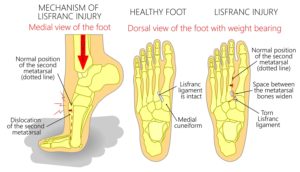
- The recommended way of doing this is to offload with a good supportive boot or cast.
- The best way to do this is, of course, to see your podiatrist and get evaluated with an x-ray, ultrasound, and potentially even an MRI or CT scan.
- If you cannot do so, it may benefit you to be in a cast, fractured boot, or even keep the weight off of it with a rolling knee scooter or other protective devices.
- We as podiatrists frequently take patients off work for a very long period of time when they suffer a traumatic injury. Unfortunately, there is no other way around us in labor jobs.
- If you have a sit-down job, there are ways to get people back to work quicker, but this can be impossible otherwise.
Top of the Foot Fracture Boot Treatment:
- There are pros and cons to using a boot to treat your foot pain. The pros are that your injured heel will hopefully have a chance to heal gradually! If you are immobilized too long, the cons are that you will gradually become stiff and overworked to your other leg. r
- Our favorite fracture boots and their supplies:
Best Fracture Boots & Covers
Best Tall Boot
Best Short Boot
Best Fracture Boot Balance Device
Best Cast Shower Cover




Price:
$79.55
$46.95
$39.95
$15.99
Overview:
Excellent reviews at 4.6/5 with over 800+ Reviews:
Very good reviews. This is 4.3/5 ratings on over 3,000+ reviews.
Outstanding reviews: 4.3/5 for 1,000+ reviews! Prevents hip, knee and back pain.
Amazing Reviews at 4.6/5 at 500+ reviews. Best reviewed and cost effective bag.
Pros:
It has an air bladder for extra cushion. It is tall for extra support, as well as air bladder.
Excellent lower cost walking boot. With a orthotic and cushion, it really keeps pressure off of your ankle.
This works great to balance the opposite foot. This prevents the back, hip and knees from having any pain.
It is very effective but not perfect. The price is really good and it has excellent reviews.
Cons:
The inner sleeve can ride lower and the plastic around the rim can irritate the boot.
Less support with the less than full length boot. It is more comfortable but less supportive.
Does not work that great for slippers and less supportive shoes.
It can still leak, so be careful!
Crucial Tips:
Make sure your lift the cushioning material along the hard plastic rim. Make sure to keep it pumped up. Use an orthotic and a lift on the other side.
Use a lift for the other foot to prevent back and hip problems. Also use an orthotic for the flat foot bed.
This is very cost effective and well worth it. Just make sure both shoes have good supportive orthotics.
Just be careful with this is not perfect. It can still get wet underneath.
Affiliate Link (Buying through these links will connect you to Amazon):
Best Fracture Boots & Covers
Best Tall Boot

Price:
$79.55
Overview:
Excellent reviews at 4.6/5 with over 800+ Reviews:
Pros:
It has an air bladder for extra cushion. It is tall for extra support, as well as air bladder.
Cons:
The inner sleeve can ride lower and the plastic around the rim can irritate the boot.
Crucial Tips:
Make sure your lift the cushioning material along the hard plastic rim. Make sure to keep it pumped up. Use an orthotic and a lift on the other side.
Affiliate Link (Buying through these links will connect you to Amazon):
Best Fracture Boots & Covers
Best Short Boot

Price:
$46.95
Overview:
Very good reviews. This is 4.3/5 ratings on over 3,000+ reviews.
Pros:
Excellent lower cost walking boot. With a orthotic and cushion, it really keeps pressure off of your ankle.
Cons:
Less support with the less than full length boot. It is more comfortable but less supportive.
Crucial Tips:
Use a lift for the other foot to prevent back and hip problems. Also use an orthotic for the flat foot bed.
Affiliate Link (Buying through these links will connect you to Amazon):
Best Fracture Boots & Covers
Best Fracture Boot Balance Device

Price:
$39.95
Overview:
Outstanding reviews: 4.3/5 for 1,000+ reviews! Prevents hip, knee and back pain.
Pros:
This works great to balance the opposite foot. This prevents the back, hip and knees from having any pain.
Cons:
Does not work that great for slippers and less supportive shoes.
Crucial Tips:
This is very cost effective and well worth it. Just make sure both shoes have good supportive orthotics.
Affiliate Link (Buying through these links will connect you to Amazon):
Best Fracture Boots & Covers
Best Cast Shower Cover

Price:
$15.99
Overview:
Amazing Reviews at 4.6/5 at 500+ reviews. Best reviewed and cost effective bag.
Pros:
It is very effective but not perfect. The price is really good and it has excellent reviews.
Cons:
It can still leak, so be careful!
Crucial Tips:
Just be careful with this is not perfect. It can still get wet underneath.
Affiliate Link (Buying through these links will connect you to Amazon):
Offloading and Scooter treatment:
- These are favorite knee scooters and walking devices.
- If your Achilles tendonitis pain is severe, offloading can be very effective until the pain calms down.
Best Fracture Scooters
Best Crutch Free Walking Device.
Best Elevating Specific Postop or Swelling Pillow


Price:
Price not available
Price not available
Overview:
Decent reviews at 3.9/5 with 4,000+ reviews. NOT for everyone!
Very good reviews at 4.7/5 with almost 2,000 Reviews. Simple job but does it well.
Pros:
This is great for athletic and mobile people. We have found success for younger and more physically capable people.
Great pillow for the first 1-2 weeks after foot or ankle fracture and surgery. Decreased pain and swelling.
Cons:
DO NOT get this if you are older, have poor balance and poor mobility. Higher fall risk.
Basically it is a pillow that costs $50, if you are tight on money, don’t get it.
Crucial Tips:
This is better for very mobile and physically capable people. Do not get this if you have poor weight control or poor balance.
It can be very effective and does a great job, but if you are tight on cash, use it on a better boot or scooter.
Best Fracture Scooters
Best Crutch Free Walking Device.

Price:
Price not available
Overview:
Decent reviews at 3.9/5 with 4,000+ reviews. NOT for everyone!
Pros:
This is great for athletic and mobile people. We have found success for younger and more physically capable people.
Cons:
DO NOT get this if you are older, have poor balance and poor mobility. Higher fall risk.
Crucial Tips:
This is better for very mobile and physically capable people. Do not get this if you have poor weight control or poor balance.
Affiliate Link (Buying through these links will connect you to Amazon):
Best Fracture Scooters
Best Elevating Specific Postop or Swelling Pillow

Price:
Price not available
Overview:
Very good reviews at 4.7/5 with almost 2,000 Reviews. Simple job but does it well.
Pros:
Great pillow for the first 1-2 weeks after foot or ankle fracture and surgery. Decreased pain and swelling.
Cons:
Basically it is a pillow that costs $50, if you are tight on money, don’t get it.
Crucial Tips:
It can be very effective and does a great job, but if you are tight on cash, use it on a better boot or scooter.
Affiliate Link (Buying through these links will connect you to Amazon):
Walk This Way: Trusted Foot & Ankle Information
Learn what’s hurting and how to fix it.
Book Your Appointment Today—Relief Starts with One Call
Fast, Friendly, and Professional Treatment You Can Trust
Dorsal Compression Syndrome: Top Foot Pain Questions Answered by Experts
Dorsal Compression Syndrome is a condition where the structures on top of the foot—often tendons and small joints—get compressed, especially during activities like walking, running, or wearing tight shoes. This can lead to pain, swelling, and limited mobility.
It’s commonly caused by biomechanical issues such as high arches, tight footwear, or repetitive stress from sports. Poor foot alignment and inflammation of the midfoot joints can also contribute to this condition.
Typical symptoms include a sharp or aching pain on the top of the foot, swelling, sensitivity to pressure from shoes, and discomfort that worsens with physical activity or standing for long periods.
A podiatrist will conduct a physical exam and may order imaging like X-rays or an MRI to rule out fractures, arthritis, or other conditions. An accurate diagnosis is key to selecting the best treatment approach.
While rest and at-home care may relieve symptoms temporarily, ongoing compression without proper treatment can lead to chronic pain or worsening of the condition. Seeking professional care ensures long-term relief.
Treatments include custom orthotics, physical therapy, anti-inflammatory medications, footwear modifications, and in some cases, corticosteroid injections or minimally invasive procedures.
If you’ve had persistent top-of-foot pain for more than a week, or the discomfort is affecting your mobility, it’s time to consult a foot specialist. Early intervention can prevent complications.
At Balance Foot & Ankle Specialist in Howell and Bloomfield Hills, Dr. Tom Biernacki and our team offer state-of-the-art diagnostics and tailored treatment plans for Dorsal Compression Syndrome. Our goal is to get you back on your feet—pain-free and with confidence.
